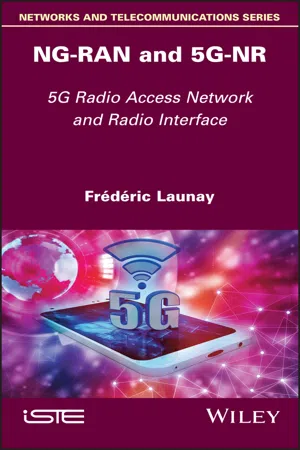
NG-RAN and 5G-NR
5G Radio Access Network and Radio Interface
Frederic Launay
- English
- ePUB (handyfreundlich)
- Über iOS und Android verfügbar
NG-RAN and 5G-NR
5G Radio Access Network and Radio Interface
Frederic Launay
Über dieses Buch
NG-RAN and 5G-NR describes the deployment of 5G NSA (non standalone 5G) and 5G-SA (standalone 5G). 5G-NSA deals with radio access entities. For the 5G-NSA mode, dual MR DC connectivity is based on radio measurements, allowing the master 4G base station MeNB to add or remove a secondary 5G node SgNB. This book describes the architecture of the NG radio access network and the 5G-NR radio interface according to the 3GPP (3rd Generation Partnership Project) specifications. The overall architecture of the NG-RAN, including the NG, Xn and F1 interfaces and their interaction with the radio interface, are also described. The 5G-NR physical layer is mainly connected by implementing antennas, which improves transmission capacity. 5G-SA deals with the 5G Core network. In the 5G-SA model, the mobile is attached to the 5G Core network through NG-RAN. The book explains radio procedure, from switching on a device to establishing a data connection, and how this connection is maintained even if mobility is involved for both 5G-SA and 5G-NSA deployment. NG-RAN and 5G-NR is devoted to the radio access network, but mobile registration, establishment procedures and re-establishment procedures are also explained.
Häufig gestellte Fragen
Information
1
NG-RAN Network – Functional Architecture
1.1. Functional architecture NSA/SA
- – SA is a completely new core service-based architecture: each radio node is autonomously controlled by the 5G core network. A service-based architecture delivers services as a set of NFs (Network Functions). NFs in the 5G core network are cloud native;
- – NSA relies either on the 4G core network or on the 5G core network. NSA anchors the control signaling to the core network through a radio MN (Master Node). The MN is either a 4G radio node or a 5G radio node. The MN controls an SN (Secondary Node) (4G radio node or 5G radio node) according to the DC (Dual Connectivity) mechanism.

- – the MN is connected to the core network for the control plan (signaling) and for the user plane;
- – the SN is controlled by the MN. It is connected to the MN for the control plane (C-plane). The user plane (U-plane) is either connected to the MN or connected to the core network;
- – the master radio access node controls the secondary radio access node and establishes a bearer, if necessary, for the exchange of data between the two radio nodes.
- – option 3: the E-UTRAN access network is connected to the 4G core network. The master node is the 4G radio node (eNB – evolved Node B). The secondary node is the 5G radio node (en-gNB). The MR-DC architecture is called EN-DC (E-UTRAN NR Dual Connectivity);
- – option 4: the NG-RAN access network is connected to the 5G core network. The master node is a 5G radio node (gNB – next generation Node Base Station). The secondary node is a 4G radio node (ng-eNB). The MR-DC architecture is called NE-DC (NR – E-UTRAN Dual Connectivity);
- – option 7: the NG-RAN access network is connected to the 5G core network. The master node is a 4G radio node (ng-eNB – next generation eNB). The secondary node is a 5G radio node. The MR-DC architecture is called NGEN-DC (NG-RAN E-UTRAN NR Dual Connectivity).
